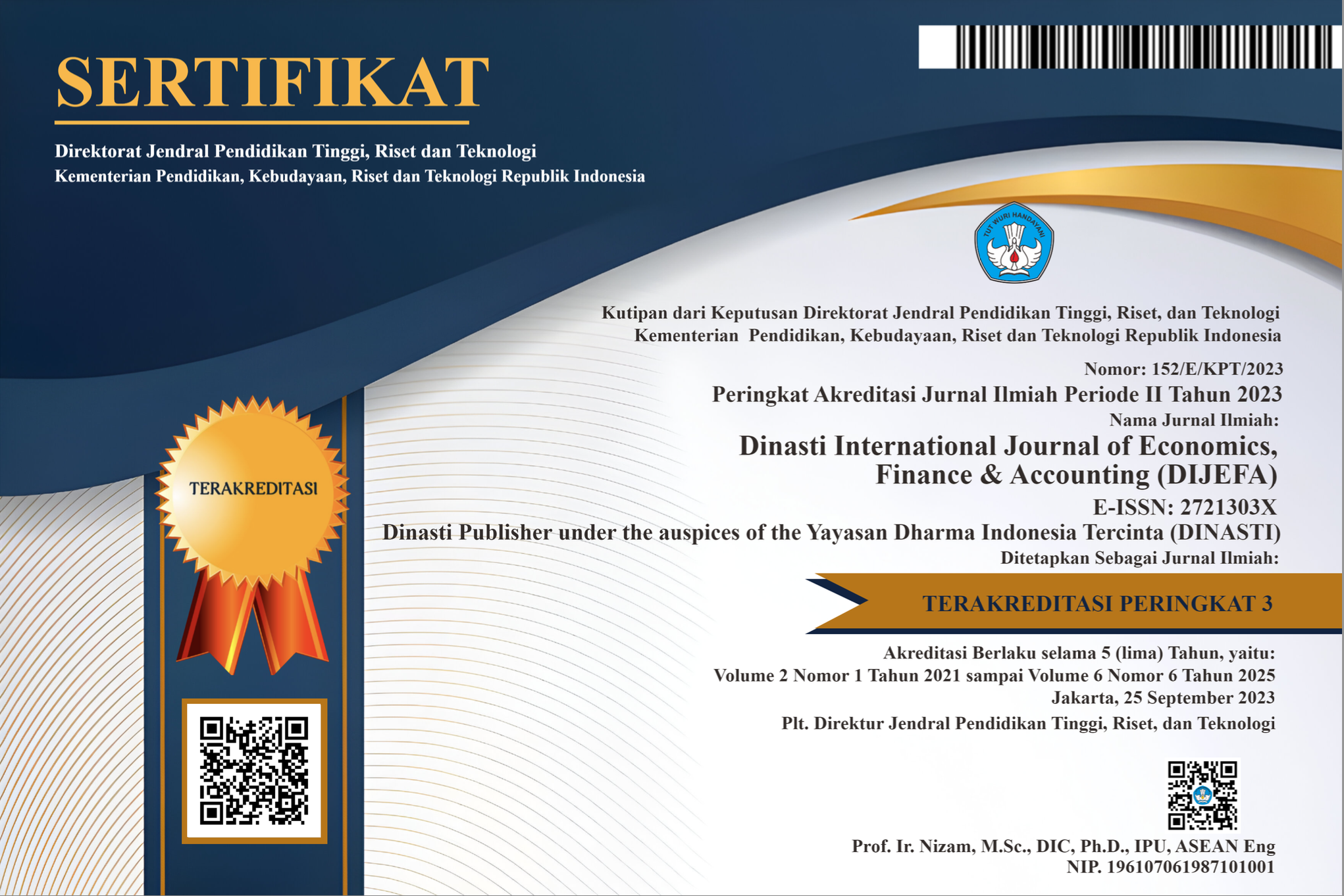Application Of Omni-Channel Strategy In Optimizing The Supply Chain Digitalization Process In Indonesia (Case Study: PT X)
DOI:
https://doi.org/10.38035/dijefa.v5i3.2976Keywords:
supply chain, omnichannel, game theoryAbstract
PT X is a staple food producer company that employs a make-to-stock (MTS) production strategy. In the implementation of MTS used by PT X, customer needs are met through the sale of ready-made product stocks. The advent of the digitalization era has introduced new strategies that can be applied in the development of the supply chain, particularly in Indonesia. To achieve success in the digitalization process, the omnichannel function involves integrating online and offline channels and providing real-time information and services to customers to enhance their engagement. A profound understanding of omnichannel implementation is required, and this research utilizes a game theory approach as a tool to assess the success of omnichannel. Subsequently, a comparison of the best strategies generated in the game theory modeling needs to be conducted. The aim of this research is to enable companies to have a strategy in digitalization implementation to be more responsive to market changes and meet the increasing expectations of customers. However, to achieve success in omnichannel implementation, companies need to invest and commit to facing challenges and optimizing opportunities offered by this strategy.
References
Adivar, B., Hüseyino?lu, I. Ö. Y., & Christopher, M. (2019). A Quantitative Performance Management Framework For Assessing Omnichannel Retail Supply Chains. Journal Of Retailing And Consumer Services, 48, 257–269. Https://Doi.Org/10.1016/J.Jretconser.2019.02.024
Agustina, L. (N.D.). Peran Customer Engagement Dan Relationship Program Receptiveness Dalam Memediasi Pengaruh Omnichannel Integration Quality Terhadap Customer Loyalty (Studi Pada The Body Shop Indonesia).
Ahmatang, A., & Indah, I. (2023). Penentuan strategi bersaing produk aplikasi pemesanan grab-food dan go-food tarakan: Pendekatan teori permainan. INOVASI, 19(2). https://journal.feb.unmul.ac.id/index.php/INOVASI/article/view/12927
Bai, S., & Jiang, M. (2022). Optimal Omnichannel Development Strategy in O2O Supply Chain under the Impact of Webrooming. Mathematical Problems in Engineering, 2022, 1–13. https://doi.org/10.1155/2022/7798236
BI-Rate Held at 6.25% Strengthening Stability and Maintaining Growth from Impact of Global Spillovers. (n.d.). Retrieved June 9, 2024, from https://www.bi.go.id/en/publikasi/ruang-media/news release/Pages/sp_2610824.aspx
Chang, V., Doan, L. M. T., Ariel Xu, Q., Hall, K., Anna Wang, Y., & Mustafa Kamal, M. (2023). Digitalization in omnichannel healthcare supply chain businesses: The role of smart wearable devices. Journal of Business Research, 156, 113369. https://doi.org/10.1016/j.jbusres.2022.113369
Chen, X., & Zhou, J. (2021). The complexity analysis and chaos control in omni-channel supply chain with consumer migration and advertising cost sharing. Chaos, Solitons & Fractals, 146, 110884. https://doi.org/10.1016/j.chaos.2021.110884
Chen, Z., & Su, S.-I. I. (2021). Omnichannel consignment supply chain cooperation: A comparative analysis of game-theoretical models. International Journal of Management Science and Engineering Management, 16(3), 151–164. https://doi.org/10.1080/17509653.2021.1911004
Das, K. (n.d.). McKinsey Indonesia Of?ce October 2016.
He, Y., Xu, Q., & Wu, P. (2020). Omnichannel retail operations with refurbished consumer returns. International Journal of Production Research, 58(1), 271–290. https://doi.org/10.1080/00207543.2019.1629672
Hu, Q., & Xu, B. (2019). Differential Game Analysis of Optimal Strategies and Cooperation in Omni-Channel Organic Agricultural Supply Chain. Sustainability, 11(3), 848. https://doi.org/10.3390/su11030848
Ji, G., Fu, T., Chen, J., & Tan, K. H. (2022). Optimal Online Service Strategy and Price Decision in Omnichannel Retail. Mathematical Problems in Engineering, 2022, 1–35. https://doi.org/10.1155/2022/8698309
Li, G., Li, L., & Sun, J. (2019). Pricing and service effort strategy in a dual-channel supply chain with showrooming effect. Transportation Research Part E: Logistics and Transportation Review, 126, 32–48. https://doi.org/10.1016/j.tre.2019.03.019
Li, Y., Li, G., Tayi, G. K., & Cheng, T. C. E. (2019). Omni-channel retailing: Do offline retailers benefit from online reviews? International Journal of Production Economics, 218, 43–61. https://doi.org/10.1016/j.ijpe.2019.05.002
Mahboob Ghodsi, M., & Zaccour, G. (2022). Omnichannel Fulfillment Strategies and Sales Credit Allocation. SSRN Electronic Journal. https://doi.org/10.2139/ssrn.4108015
Momen, S., & Torabi, S. A. (2021). Omni-channel retailing: A data-driven distributionally robust approach for integrated fulfillment services under competition with traditional and online retailers. Computers & Industrial Engineering, 157, 107353. https://doi.org/10.1016/j.cie.2021.107353
Nugroho, S. P., Lestari, N. S., & Priyono, E. (2023). Pengaruh Omnichannel Integration Quality Terhadap Niat Pembelian Dimediasi Kepercayaan Konsumen Di Surakarta. 1(2).
Palmatier, R. W., Sivadas, E., Stern, L. W., & El-Ansary, A. I. (2019). Marketing channel strategy: An omni-channel approach. Routledge. https://www.taylorfrancis.com/books/mono/10.4324/9780429291999/marketing-channel-strategy-robert-palmatier-louis-stern-adel-el-ansary-eugene-sivadas
Putri, R. A., & Purnama, H. (2023). Penerapan Omnichannel Untuk Caring Pelanggan Indihome Pada Customer Care Telkom Witel Bandung. WACANA: Jurnal Ilmiah Ilmu Komunikasi, 22(1), 155–165. https://doi.org/10.32509/wacana.v22i1.2770
Xu, J., Bai, Q., Li, Z., & Zhao, L. (2023). Maximizing the Profit of Omnichannel Closed-Loop Supply Chains with Mean-Variance Criteria [Preprint]. SSRN. https://doi.org/10.2139/ssrn.4526747
Downloads
Published
How to Cite
Issue
Section
License
Copyright (c) 2024 Reinardus Andoni Nasera Putra, Rahaditya Dimas Prihardianto, Paramaditya Arismawati

This work is licensed under a Creative Commons Attribution 4.0 International License.
Authors who publish their manuscripts in this journal agree to the following conditions:
- The copyright on each article belongs to the author(s).
- The author acknowledges that the Dinasti International Journal of Economics, Finance & Accounting (DIJEFA) has the right to be the first to publish with a Creative Commons Attribution 4.0 International license (Attribution 4.0 International (CC BY 4.0).
- Authors can submit articles separately, arrange for the non-exclusive distribution of manuscripts that have been published in this journal into other versions (e.g., sent to the author's institutional repository, publication into books, etc.), by acknowledging that the manuscript has been published for the first time in the Dinasti International Journal of Economics, Finance & Accounting (DIJEFA).


























































